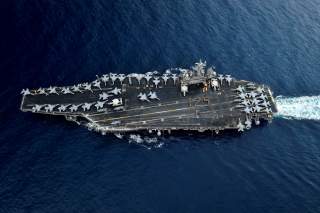Why Russia's Dream a Nuclear-Powered Carrier Won't Happen Yet
Will it ever?
Key point: Moscow is thinking hard about how to replace its sole (and aging) carrier.
The Russian navy has revealed a scale model of a possible, nuclear-powered replacement for its sole aircraft carrier, the conventional Admiral Kuzentsov.
Butt the Kremlin for years has celebrated scale models of future flattops, all without spending any money to actually design or build the vessels.
The longer the Russian navy waits, the less likely it is that a new carrier directly will replace Kuznetsov when the aging, unreliable ship finally decommissions.
A defense-industry source said the Kremlin had begun a technical assignment for a future nuclear-powered carrier under program name Project 11430E Lamantin, TASS reported in July 2019.
But the Russian navy’s own commander-in-chief, Nikolai Yevmenov, told reporters there was no firm deadline for funding or construction. "There will be, of course, a nuclear-powered aircraft carrier but not in the short-term perspective," Yevmenov said.
The model of the Project 11430E carrier indicates a large vessel similar in size and layout to the U.S. Navy’s own nuclear carriers. The 1,100-feet-long Lamantin would displace up to 90,000 tons of water, boast a three-month endurance be capable of a top speed of around 30 knots, TASS reported.
It’s unclear how much Lamantin would cost. The United States possesses an efficient carrier-building industry that produces a new flattop roughly every five years and still spends as much as $13 billion per vessel.
Russia’s entire annual military budget rarely exceeds $70 billion. Only a small fraction of that typically pays for ships.
The high cost of a replacement vessel perhaps explains why the Kremlin is determined to keep Kuznetsov in service as long as possible. The Russian navy plans to dry-dock Kuznetsov starting in 2020 and conduct extensive repairs on the 1980s-vintage vessel.
A previous effort to dry-dock and repair Kuznetsov ended in disaster in October 2018. The carrier suffered serious damage at the 82nd Repair Shipyard in Roslyakovo, a northern port city, when the PD-50 dry-dock sank.
Swedish-built PD-50 was the only large dry-dock capable of supporting the Russian northern fleet’s largest warships. Russia's other large dry-docks are thousands of miles from the fleet's main northern bases.
Moving the docks, or the ships needing repair, could be prohibitively difficult, expensive and time-consuming. Beside the cost, foreign sanctions complicate the acquisition of a dock similar to PD-50.
According to the newspaper Izvestia, the Kremlin considered just decommissioning Kuznetsov rather than spending the money to acquire a new dry-dock, move an existing dock or the carrier or find some other way of repairing the accident-prone flattop.
Kuznetsov rarely goes to sea and conducted just six patrols between 1991 and 2015. During a 2016 mission off of Syria, the ship’s air wing lost two jets in just three weeks.
“Not everyone considers the continuation of repair to be appropriate,” a navy source reportedly told Izvestia following the PD-50 sinking. “There are different opinions, including those that boil down to the fact that with this money it is better to build a pair of frigates or a nuclear submarine.”
But there was intensive pressure to keep the carrier, two experts explained in Proceedings, the professional journal of the U.S. Naval Institute.
“As Russia’s only aircraft carrier and its flagship, the Kuznetsov’s main mission is projecting national prestige,” wrote Richard Moss and Ryan Vest, both instructors at the U.S. Naval War College. “From that perspective, Russia must overhaul her and get her back into service as quickly as possible.”
By spring 2019 a plan reportedly was in place to assemble a new dry-dock that in theory could accommodate the carrier, Moss and Vest explained. The No. 35 Ship Repair Plant in Murmansk in northern Russia has two, adjacent 200-meter-long dry-docks that yard workers could combine in order to fit Kuznetsov.
“However, the modifications may not be as easy as the source would have us believe,” Moss and Vest wrote. “Even after the two dry-docks are combined, they will have to be lengthened to accommodate the 305-meter ... aircraft carrier, and a new gate structure of the combined dock will have to be custom fabricated.”
Considering the labor and expense involved, the work might not proceed according to the current schedule. “Considering the necessary dry-dock modifications, the current fiscal realities the Russian government is facing under sanctions and lower oil prices and endemic corruption, the Kuznetsov may be undergoing modernization for the foreseeable future,” Moss and Vest explained.
Even if Kuznetsov can be repaired, the navy most likely strictly will use the carrier as a training ship, a Kremlin source told Belsat, a Belarusian news agency.
As Americans, Moss and Vest sarcastically advised Moscow to continue pouring money and effort into Kuznetsov. “Russia will be doing NATO and the U.S. Navy a huge favor if it decides to spend the money, repair-yard time, and human capital needed to overhaul the ski-jump-ramp carrier that is clearly an albatross of the Cold War era.”
A new nuclear-powered carrier costing one-fifth of Russia’s entire annual military budget might be an even bigger albatross. Not that Russia is likely to build such a vessel any time soon.
David Axe serves as Defense Editor of the National Interest. He is the author of the graphic novels War Fix, War Is Boring and Machete Squad. This first appeared in July 2019.
Image: Reuters.

